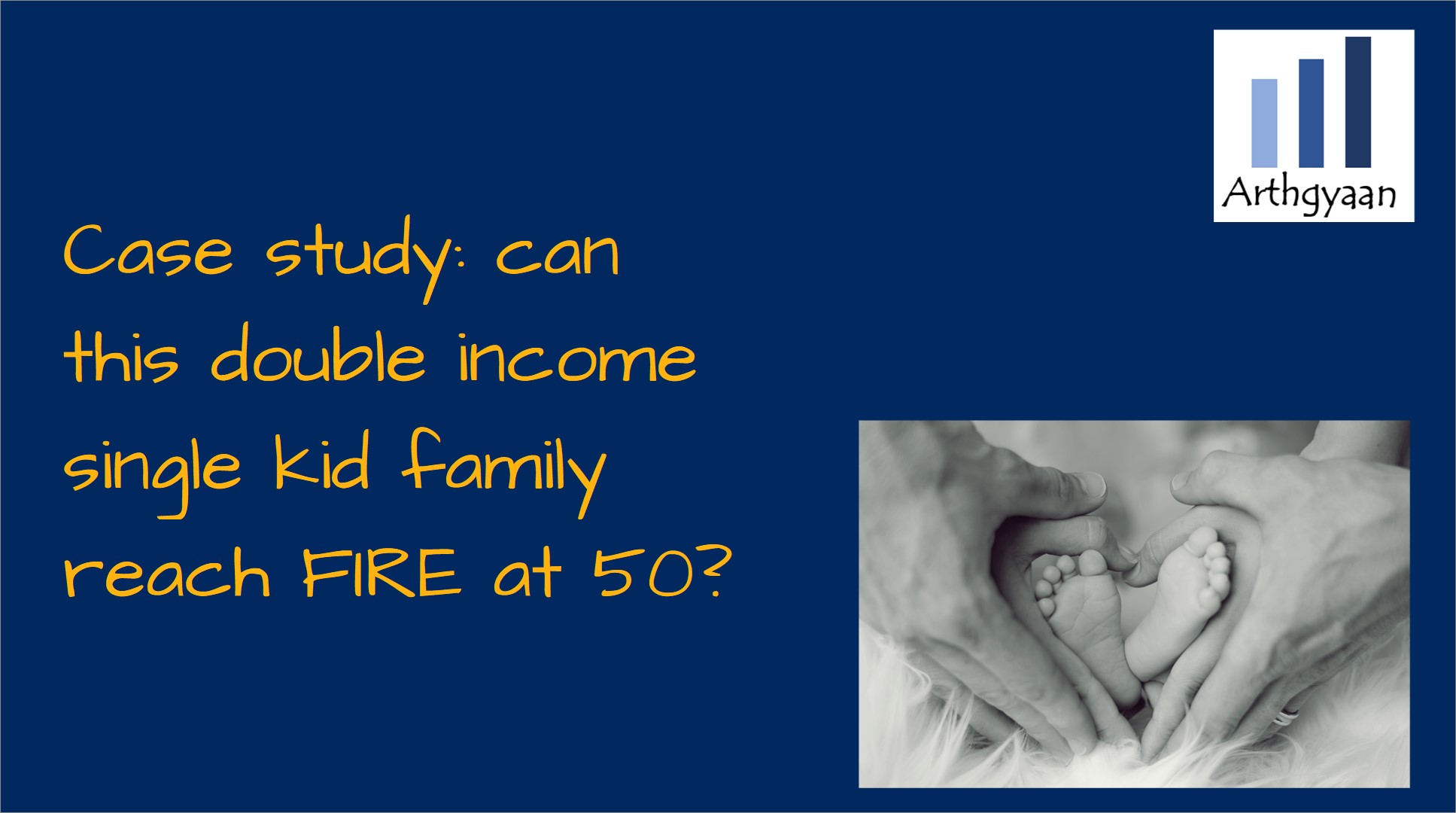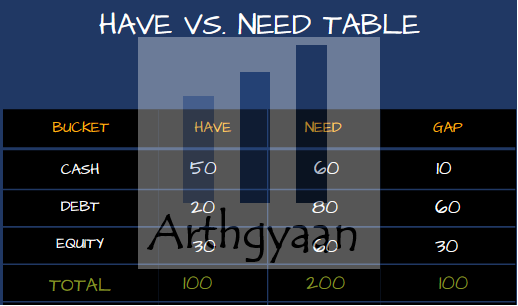Case study: can this double income single kid family reach FIRE at 50?
This article shows how a double-income couple with a 2-year old reach their FIRE dream at the age of 50.
This article shows how a double-income couple with a 2-year old reach their FIRE dream at the age of 50.

This article uses the Arthgyaan goal-based investing calculator to understand how much corpus is needed to have a comfortable lifestyle in India.
This article shows how a single-income middle-aged couple with two small children reach their retirement and children’s goals.
This article shows how a double-income couple with a 2-year old reach their FIRE dream at the age of 50.
This article shows how a double-income couple with a newborn child can invest for their future goals of FIRE and real-estate investment.
This article shows how a young just-married couple can invest for future goals using the Arthgyaan goal-based investing tool.
Did you welcome a bundle of joy in your 40s? This article will discuss ways of planning the child’s (and your’s financial future)
This article shows how a very typical salaried couple with one child can invest for future goals using the Arthgyaan goal-based investing tool.
The total market value of these assets:
To build a house, you need to first build a strong foundation
Goal-based investing requires completing some steps to ensure that the investment plan is seamlessly executed without breaks due to unforeseen circumstances. We will follow the steps described here: I have heard of goal-based investing. What now?
Risk profiling is a mandatory step that should be completed before investing in goals. A portfolio created for a goal has one purpose: to meet the goal. Therefore, we need to balance risky assets that generally appreciate fast (like equity) and slow-growing assets that provide stability (like debt). The tool that is used to determine this mix of investments is risk profiling. Risk profiling, if not done, leads to a high chance of missing the goal. Being invested in the wrong asset class in the wrong proportion (either equity or debt) can lead to either high risk or poor returns or worse both.
We have a risk-profiling tool here that investors should use before getting started: Do not invest in mutual funds before doing this
A minimum of 6 times total monthly expenses and EMI, which is ₹1.63L x 6 = ten lakhs. They should keep ideally this amount in a joint bank account with sweep FD. Both spouses should have debit cards and net banking access to this bank account to get immediate access in terms of need. However, in this case, they have ~₹23 lakhs parked in savings accounts. This amount together with high-value credit cards will easily cover standard emergencies.
As expenses increase or the emergency fund is used up, the current month’s investments should be diverted until the fund is rebuilt.
Given that this value of cash in savings account is very high, we will explore how to deploy the amount based on goals in the following sections.
Krish has only a corporate group cover of ₹50 lakhs as term insurance.
As we will see below, this coverage amount is not enough considering their goals. Given the value of their goals today, they need at least ₹6 crores of insurance between them. Two additional life insurance policies of ₹3 crores per head, given their age and 20-year coverage, should cost a total of around ₹70,000/year. Any existing medical conditions must be declared at the time of taking the policies and there must be a physical medical test.
This step should be taken immediately.
Here is a guide regarding purchasing term insurance policies: Term life insurance: what, why, how much to get and from where?.
There should generally be the following policies that a family should have at a minimum:
Here is a guide regarding purchasing health insurance policies: Health insurance: what, why, how much to get and from where?
The purpose of the personal accident (PA) insurance policy is to provide a replacement for your income if you have an accident and cannot work after that. Unlike term insurance, where claims are paid on death, a PA cover is applicable when one of the following is the result of an accident:
The family should therefore take ₹1-2 crore personal accident insurance each for Krish and Megha with a total premium of around ₹17,000-35,000.
Fortunately, the family has no high-interest loans like credit cards or personal loans.
The family is currently having home loan with a moderate outstanding amount. As a family, they are currently paying an EMI of ₹48k/month plus a large amount of ₹25k/month as prepayment. The loan is insured up to ₹50 lakhs.
Here is something that the family should consider:
We will use this retirement expense estimation tool to calculate today’s expenses and determine how much to spend in retirement.
To know how much you can invest for goals (the investible surplus), you need to classify and figure out approximately the major monthly expense heads under the three main buckets below:
Given that they have a 2-year old baby, their expenses will likely shoot up once the child starts going to school. The current expenses do not consider this point.
Having clear financial goals is the first and vital step before investing. We will use the SMART framework to write down goals:
We will assume that the family can increase its investments by 7% every year via upskilling and improving their human capital: Your human capital, not investment returns, is your biggest wealth creator. Given the importance of human capital, the family should allocate an upskilling line item in the monthly budget. The family can use this for courses, books and other related purposes.
Before going into the details of the goals, if you, dear reader, wish to cover another scenario as a Case Study, click the button below:
Please note that this is a paid service.
The SMART framework is applied like this:
If you are planning your FIRE journey, then Arthgyaan packages can help you create and manage your FIRE portfolio effortlessly. Choose the year closest to your desired FIRE year to get started:
Children’s goals are very precious for a family. However, given the much shorter horizon for purposes like an UG degree, the monthly investment amount can be surprisingly higher.
To implement all the steps related to investing for your child’s college goals in one easy-to-follow package, we have Arthgyaan Child Education goal packages. Choose the year closest to your desired college admission year to get started:
The table shows the SIP amounts split amongst different goals and the portion of the current corpus allocated to each goal. Investors have two approaches to investing:
We use the Arthgyaan Goal-based investing calculator to formulate the investment model with all the above assumptions and goals. There is a link to download a pre-filled copy of the Google sheet via the button below.
Important: You must be logged into your Google Account on a laptop/desktop (and not on a phone) to access the sheet.
Once you get your sheet, you can access video tutorials in the howto tab.
For most investors, this is the most critical question. It is a variation of finding the ‘best’ of everything: the best mutual fund, PMS service, insurance policy, etc. However, if you have followed the process until now, you will realise that coming to this stage is the very end of the goal-based investing strategy.
We will keep this simple with some typical investments that the family can follow and should be sufficient for their purpose.
As time passes, three things happen:
These factors will require a portfolio review exercise every 6-12 months. Then, the process goes through the above steps: goal setting, capturing current asset values, and feeding them into the model to recalculate the numbers. The concept is explained here: Are your investments on track for your goals?
This section shows the current and target asset allocations for equity, debt and cash. The action on the investor will be to immediately implement the rebalancing plan as shown in the image.

The plan requires that a good amount of the cash holding to be moved to equity today using the Arthgyaan Have-vs-Need framework (image above) whose output we have seen in the rebalancing plan section.
Many investors have a lot of doubts as to the best way of moving a sum from cash top equity. In the bigger scheme of things, any sort of tactical market timing has no impact on future returns solely because once the full amount is invested, it is now exposed fully to market movements: SIP vs. lump sum: what should I choose?
The family has an in-hand income of ₹4L/month including ₹40,000/month going into EPF. Along with the ₹75k/month home EMI payments (₹48k/EMI plus ₹27k prepayment), they spend a total of ₹1.63L/month. These expenses leave them with an investible surplus of ₹2.37L/month which is insufficient as per the model output. However, if they stop prepaying the home loan, then the gap can be filled easily.
Therefore the tradeoff is between reaching FIRE 10 years before vs. being debt free quickly. We suggest that the family considers this tradeoff carefully and acts as per their requirement.
There are some common mistakes that investors make which prevent them from benefiting from compounding. We cover this concept in more detail here: 12 mistakes that interrupt compounding: what to do instead.
In this case, the family is doing well in creating and following a goal-based investment process and they should continue it.
We are a big advocate of both
This position is due to our opinion that real-estate investments, after buying the primary residence, should be attempted only after primary goals (retirement / FIRE, children-related etc.) are fully funded vs. market-linked assets like stocks and bonds. We are also seeing the rapid increase in real-estate in major metro cities. We have made our case on this topic in detail here: Why parents should invest for the downpayment of their child’s first home?.
In this case, the family wishes to give their son a gift on his 25th birthday. That gift can easily be a contribution towards the downpayment of their first home.

Published: 18 December 2025
8 MIN READ
1. Email me with any questions.
2. Use our goal-based investing template to prepare a financial plan for yourself.Don't forget to share this article on WhatsApp or Twitter or post this to Facebook.
Discuss this post with us via Facebook or get regular bite-sized updates on Twitter.
More posts...Disclaimer: Content on this site is for educational purpose only and is not financial advice. Nothing on this site should be construed as an offer or recommendation to buy/sell any financial product or service. Please consult a registered investment advisor before making any investments.
This post titled Case study: can this double income single kid family reach FIRE at 50? first appeared on 17 May 2023 at https://arthgyaan.com